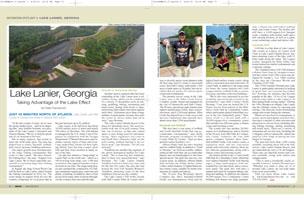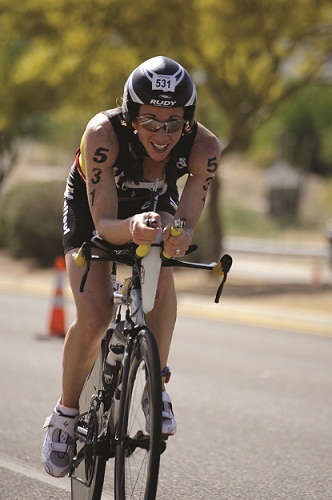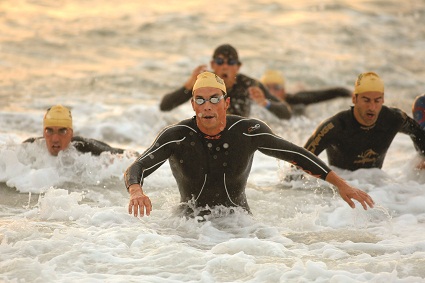
 |
| Photo courtesy of brightroom.com |
The popularity of the triathlon in the U.S. is at an all-time high in the U.S. And that's not hyperbole. The numbers speak for themselves.
In 1982, the U.S. Triathlon Association and the American Triathlon Association merged under one unified national governing body called the U.S. Triathlon Association, with 1,500 members. The years following have seen the sport grow exponentially in the United States. Now known as USA Triathlon, the organization has a membership that exceeds 150,000.
While the organization's reputation is primarily as an adult event, it's also attracting younger participants. Many triathlons are now being billed as 'triathlon festivals,' and are adding youth events, with the traditional swim-bike-run format offered, but shortened, and held on closed courses for kids.
 |
| Photo courtesy of brightroom.com |
Why is triathlon so popular? A combination of factors, really. Public awareness of the sport has grown, thanks to high-profile, big-name events like the Ironman races. Plus, triathlon first appeared as an event in the 2000 Olympic Games in Sydney, Australia, and because it received great television coverage in the U.S., it landed in the national consciousness. Then, of course, there's a growing interest in varied workouts, the all-important ego factor -- and of course, the need to check off a box on the 'bucket list' or compete on behalf of a charity.
But whatever the reason(s) for the popularity, it has resulted in more triathlons being planned. And planning a triathlon takes work and preparation, much the same way training for one takes work and preparation. Someone who knows this is Liz Tucker, multisport program manager at USA Triathlon, the sport’s National Governing Body. Want to learn? Read on.
 |
| Sportgraphic/Dreamstime.com |
What makes planning a triathlon unique?
It's really a different kind of event planning. You're not just planning a run, which is complex itself, you're holding a swim and a bike event too. When you bring in those extra sports, you add more complexity. You are dealing not just with roads, but with water. You're setting up three event courses that have to work together. There are a lot of details.
Describe the planning that goes into the swim event:
Water testing is very important. There are specific rules concerning water quality, and concerning how long that quality has to be maintained. USA Triathlon's requirement is that the jurisdiction overseeing the body of water sets the standards. If, for example, you're swimming in a county-owned lake, that county will determine what makes the water safe for swimming. They'll generally be looking for things like the presence of E.coli, fecal coliform -- it really varies by location. Something else to know is that different things will affect your water quality. In the Midwest in late summer, for example, you have the goose migration, and that might result in higher bacteria levels. River swims can be really tricky because water runoff can change the quality of the water and how fast the river is moving. That is why we rely on the local jurisdictions' requirements; they know their areas best.
 |
| Photo courtesy of brightroom.com |
What about the bicycling event?
In a perfect world you would have a course for bicycling and running that is closed to vehicle traffic, but unfortunately, you can't get that in most events. If the course is open to regular traffic, it needs to have a lane or shoulder set aside for bikes. That lane needs to be wide enough for cyclists to ride safely, plus it needs to have enough space for them to pass one another safely. Obviously, closed courses are ideal, but we don't see that very often because it is so hard and so expensive to close a road.
Is the running leg of the event easier?
With running events, you have lots more flexibility. Runners can go through neighborhoods, and they can use trail systems. But with all three events, your biggest concern is always going to be keeping the athletes safe.
Is the permitting process for a triathlon more complicated?
 |
| Photo courtesy of brightroom.com |
The permitting process is similar to that of a one-sport event, but depending on how big your course is, it can be a lot more complex. Some of the races sanctioned by USA Triathlon will cross multiple city and county or even state lines, and you have to coordinate the requirements for permitting in each jurisdiction. So in terms of police support, you would have state police monitor anything on a state road or highway, and if part of the race is on county land, the county police would oversee that area. You have to determine who controls each piece of the race course, including the swim. That means you have to know who owns that water and whose responsibility it is. You also have to know where you're going to transition between sports, where people are going to park, and whose responsibility that land is. It's a lot of details to pull together.
What about medical support?
Fortunately, everyone recognizes the importance of medical support. Something new we're seeing is awareness of the type of medical support to have. People want to know if there is an AED (automated external defibrillator) on site, whether there is someone who can do advanced life support as well as basic life support. And as these races become more of an annual event for communities, the organizers start to see the benefit of working with the same medical support teams year after year, since those teams will know what to expect in terms of the types of injuries that may come up. For example, with triathlon, some injuries are more common: broken collarbones on the bike course, people who need assistance or the opportunity to stop and rest during the swim. Someone who has done your race before will be ready to respond to those injuries and situations.
 |
| Photo courtesy of brightroom.com |
It is difficult to get insurance for a triathlon?
If you sanction your event through USA Triathlon, one of the things you get is insurance: liability insurance and participant excess medical coverage. Liability insurance covers the event itself, the event director, volunteers, any officials, athletes, sponsors and so on. Excess medical covers participants if they are injured and their costs exceed their regular insurance policy, or it will cover them if they don't have a primary policy. This is just at events that sanction with USA Triathlon. We don't require people to sanction their events, but it's available to everyone. Every event director has a choice to make about sanctioning and insurance plays a big part of that decision.
What is the biggest mistake a person can make in planning a triathlon?
One of the biggest mistakes is rushing into putting together a first-time event or using a new venue. We have a race director certification class, and a lot of people come in saying, 'Look, it's April and I'm putting on an event in August, and I need to learn how to do this.' By the end of the course, they're usually saying, 'Okay, I'm going to wait a year and do it next August.'
Any other words of advice?
Partnership with the community is really important. You want the community to have buy-in, and you want the event to be mutually beneficial for everyone. Reach out to your chamber of commerce, your sports commission, as well as sports clubs in the area. We encourage this be done very early on in the process. Get people involved. If you can get the mayor to race, or a member of the local news team, you'll get more publicity. And you can always use volunteers. If people don't want to race, they can still hand out water or cheer for racers as they go by. If you make those volunteers feel welcome and treat them right, they'll want to come back. One thing we always say is that the volunteers and spectators of today are the participants of tomorrow.
